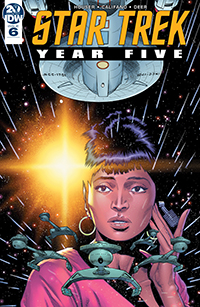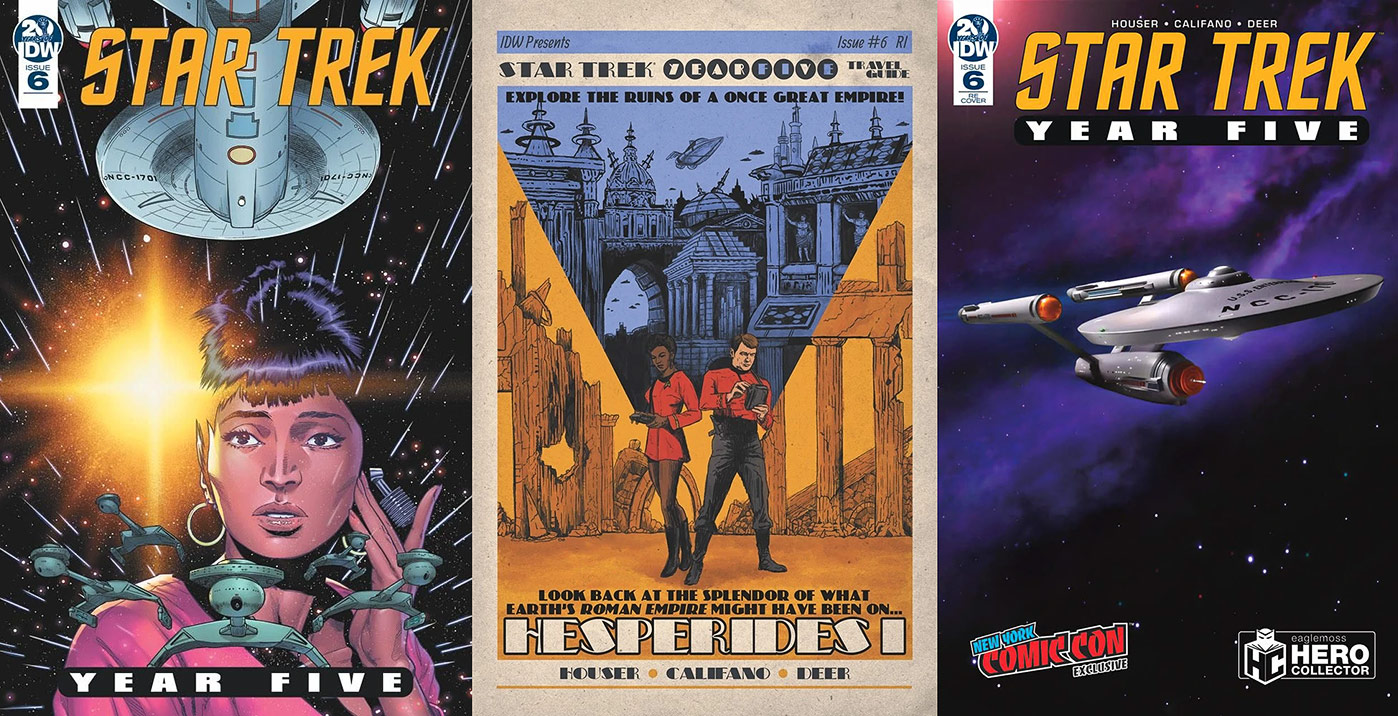Comics can be such an over-looked and under-appreciated medium.
I touched on this point with my last review of Star Trek: Year Five #5, so it’s appropriate that it’s a resurfacing topic as I look at Issue #6. It can be this lack of appreciation that makes it difficult to attract the right writers when you have a high-profile franchise like Star Trek to take care of.
You see, continuity is something that fans automatically look for and writing for Star Trek doesn’t just require talent, it also demands that the writer has a vast amount of subject knowledge to support that continuity.
Drawing comparisons. identifying possible loose ends that could spawn their own stories and a vast repository of character lore – these are all things that Trek comic writers need to keep in mind because telling stories within an established universe can be more challenging than working in your own.
It needs to be appreciated, and that brings us to Star Trek: Year Five #6 from writer Jody Houser and artists Silvia Califano, Thomas Deer and Neil Uyetake.
When we last left the crew of the Enterprise, they were experiencing the effects of an unknown alien device recovered from an archeological expedition that interfered with their ability to communicate with each other. At the same time, Lieutenant Uhura had just made a significant step forward while trying to communicate with their reluctant Tholian child refugee.
The cover, the preamble – it’s clear that this is Uhura’s issue to shine. As the communications officer, she was responsible for so many things that were explored in subsequent books and other media after TOS ended. Not only was it revealed that she was a gifted linguist, but she also was an expert in electronic warfare, surveillance and other areas that are too many to list.
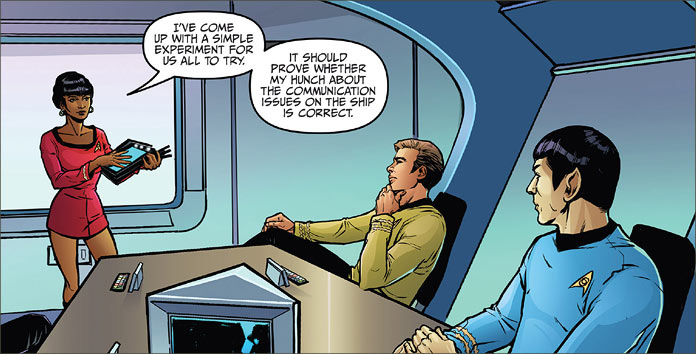
But it’s clear that Houser is aware of her capabilities and the justly-deserved focus as she works out the mystery of the effect of the archaeological artifacts – which is also gives rise to the communications breakthrough with the Tholian child, affectionately nick-named “Bright-Eyes”.
I enjoyed the fact that Houser knew enough about this character’s background from those additional continuity sources to turn this into Uhura’s comic to shine. It makes for greater appreciation of the characters of Star Trek and brings to light Houser’s adeptness with them.
The same thing can be said about her portrayal of the Klingons at this period of Captain Kirk’s career. For continuity reference, we must be close to the point when the effects of the Augment virus will start to wear off. Klingons are returning to their original forms and losing the human DNA.
Remember, we were told in Enterprise that it would take a generation or two before the full effects would be fully purged from Klingon DNA. That’s about the same time as Kirk’s final year on the first five-year mission — and the setting of the Year Five storyline.
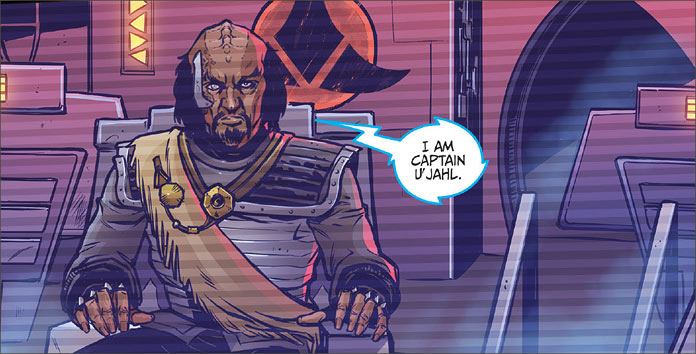
Houser makes use of that fact as the Enterprise encounters what looks like an early Bird of Prey design from the movie era, and as Kirk remarks that he’s never seen a Klingon that looks like Captain U’Jahl.
I also remarked that I had enjoyed Houser’s streamlining of the plot in last issue. This book sees that same type of focus on solving the communications mystery. However, there’s also a delightful cadence of interplay between Uhura and “Bright-Eyes” and how Houser gives us further insight into “Bright-Eyes’” character. A child, Houser shows us that the young Tholian is eager to please, as he says “did good.” It’s a soft moment that brings the reader closer to the alien and we see the child more.
Artist Silvia Califano has not disappointed in her rendering of the captain and crew of the USS Enterprise. Her work last issue was a very pleasant introduction for me to her work and I have to likewise say the same for it in this book. She excels in presenting the emotional expressions of the characters and that goes a long way in capturing likenesses.
However, I had to also admire her interpretation of the early Klingon Bird of Prey in presenting the transitional nature of this point in the Trek timeline. That must have taken research and care to carry that degree of specificity in a ship design.
The same sort of appreciation clearly went in the covers for this book as well. Stephen Thompson’s regular cover really showcases the importance of Uhura in this story, and while there might be an over-dramatization of the amount of Klingon opposition the Enterprise faces in this story, it’s a gorgeous representation of the deadly sleekness of the Klingon D-7 Battlecruiser and his portrayal of Lieutenant Uhura is stunning.
J.J. Lendl maintains his wonderful 1950’s “Travel Guide” style of presenting the story in this month’s retailer-incentive cover. He captures one of the dominant thematic elements – in this case, the archaeological expedition – and manages to extrapolate it into a fantasy piece that does more than capture our eyes; it captures our imaginations. Of course. That’s what every good Star Trek story is meant to do, and he effortlessly pulls that trick off.
Next weekend is New York Comic Con, and this month’s issue will also have a featured convention-exclusive cover variant available to fans on site; starship model licensee Hero Collector gets their own design, composited from model photography by artist Nils Walter Khan.
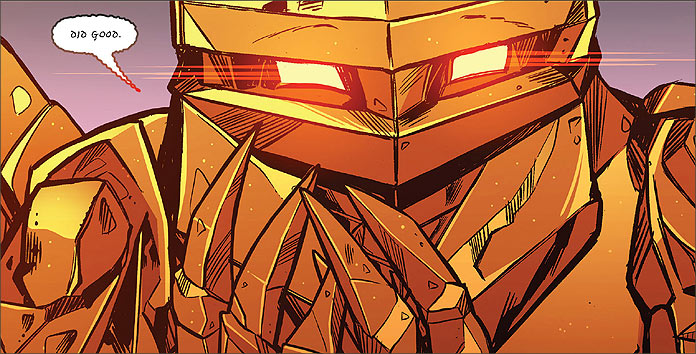
Again, it’s the appreciation that matters when writing, penciling, coloring or lettering stories about Star Trek. Comic work often gets overlooked for the long hours, the deadlines, the specificity of the fans who expect their creators to not only have the same love of the franchise that they do, but also the same amount, or more knowledge.
Comic creators are expected to write a story arc, broken up into various installments over a length of time of eventually about novella’s length or, in some cases, more. Regardless of how episodic the story is, its authenticity and enjoyment of the fans still has the same level of expectation as any other medium, and that needs to be appreciated.

